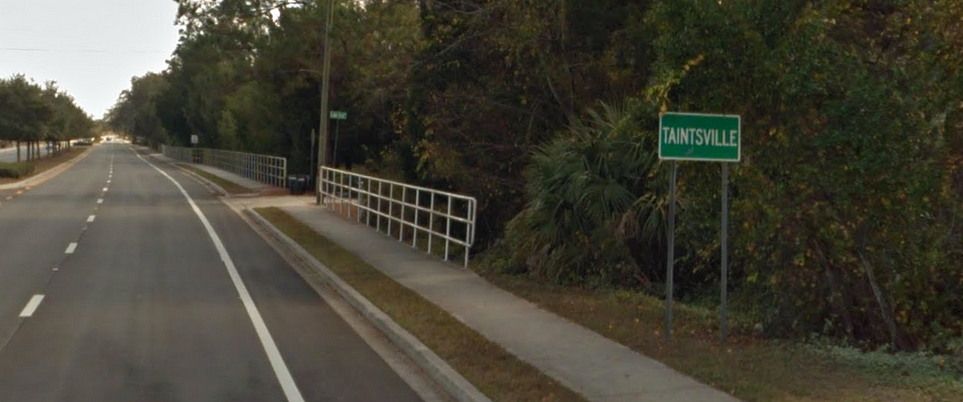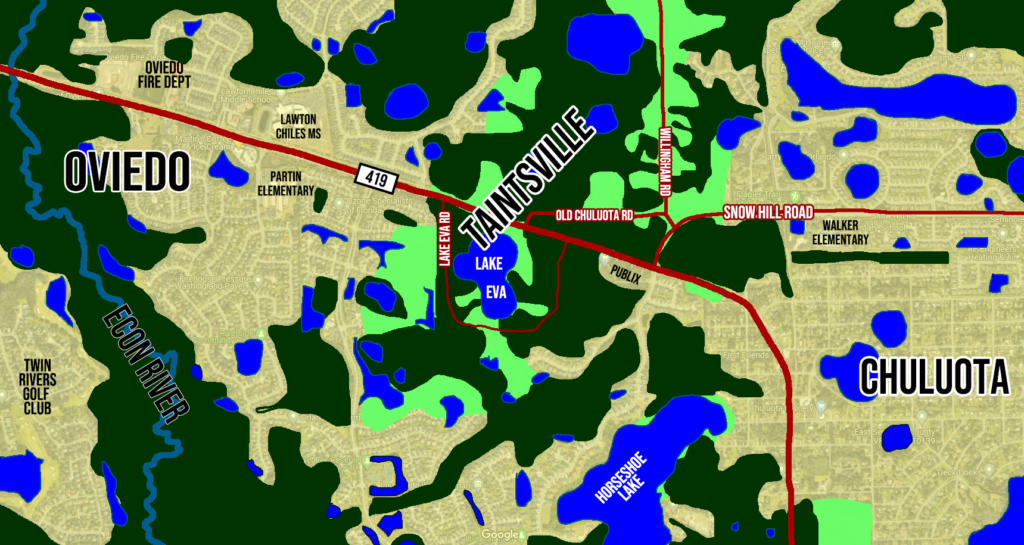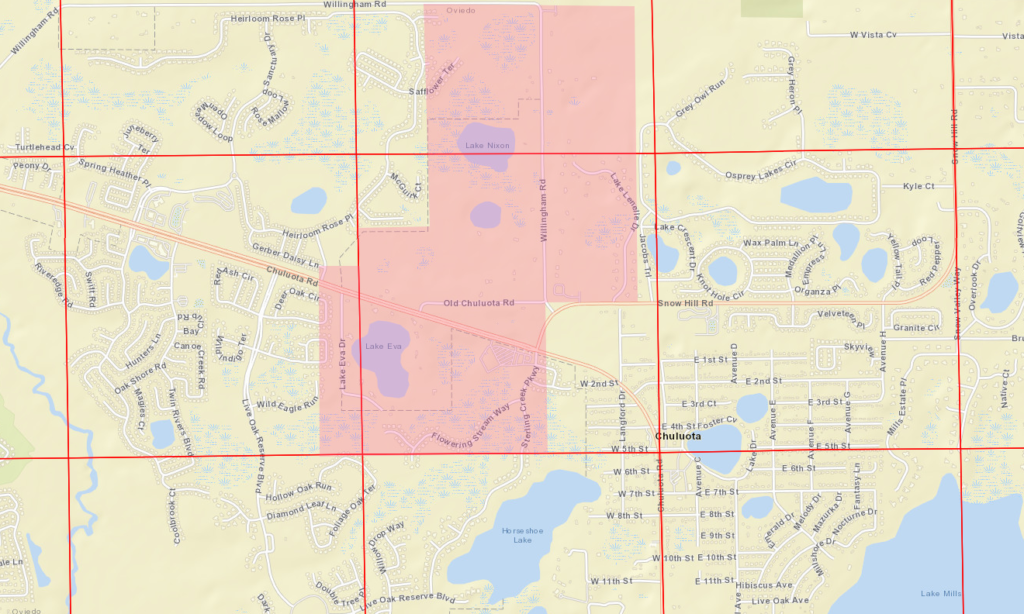Residents who lived in the rural community between Chuluota and Oviedo lacked an identity; so they created one.

Before suburban sprawl gobbled up most of the wilderness that served as a buffer between towns, there were more “in between” areas in eastern Seminole County. For rural residents caught somewhere in the middle, it was sometimes hard to explain where exactly they lived.
This was an increasingly frustrating problem for early 1970s residents around Lake Eva, then about three miles east of Oviedo and a mile west of Chuluota. Packages sometimes were not delivered and giving directions was a challenge.
“We are tired of telling people we live behind the fire tower on the road that doesn’t have a name,” said local Theodore Peterson.
The idea of inventing their own town began to circulate among the 30 or so neighboring families. It was said jokingly at first, but the suggestion got progressively more serious. They had no desire to formally incorporate; they just wanted to live somewhere. Besides that, they wanted to remain distinct from the two larger towns that sandwiched them — especially from fast-growing Oviedo, which seemed to have annexation fever.
In one such conversation, then teenager Boyd Best was tending the yard of Les and Mary Gross. He complained about the difficulties of telling friends where you live when you live nowhere.
“We ‘tain’t in Chuluota and it ‘tain’t in Oviedo either!” he exclaimed. And with that simple utterance “Taintsville” was born.

Word quickly spread and the name was embraced by locals. All were eager to make it stick. The Gross and Cochran families went in together and ordered two highway signs for $50 each from a company in Texas. Another neighbor, Ted Peterson, contributed some concrete.
One dark Sunday night the posse of town founders headed out after midnight. Stealthily they installed the markers one mile apart on either side of the unauthorized village limits.
That week a survey crew had been working in the area. When they returned to their task that Monday morning, they were rightfully confused. Were they even in the right place?
“When the survey crew came back,” Mary Gross recalled, “they didn’t know what to think. Here they were in a town that didn’t exist when they left!”

For a few days, county and state bureaucrats weren’t sure what to think about the mysterious new hamlet. The signage looked professional enough and each assumed the other had placed it. About a week later the jig was up and the government removed the signs.
The 30 families of the would-be town refused to give up so easily. In the fall of 1971, they began circulating a petition. Finally, the crew got their chance. Commissioner Greg Drummond met with the townspeople at the old fire tower and agreed to add their request to the agenda of the Commission’s December 14th meeting.
The informal organization, representing the majority of prospective town’s inhabitants, showed up in force, and apparently, they were quite convincing. The board agreed to recognize the 700-acre area as “Taintsville.”
Not long after that Rand McNally caught on, and the Village of Taintsville was added to its famed maps. With boundaries encompassing both sides of the highway and over one square mile in total area, original Taintsville claimed a population of 80 citizens.
Emboldened by their success, residents thought why not name the roads too? Another sign was secretly erected on an unnamed dirt road that ran through the village. A hand-painted sign labeled the path “Tainta Road.” However, the county wasn’t as eager to humor local comedians this time, and it was soon redubbed “Old Chuluota Road.”

Over the years, the town has had at least two de facto mayors. The first was Alfred Best (father of the boy who came up with the name), who had lived there since 1942. And then Les Gross, perhaps the most prominent resident, who “served” in the purely imaginary role until his death in 1988.
Other than its unique name, the most notable thing in town happened prior to the moniker. Legendary poet Robert Frost was a friend and frequent guest of Robert Lamont (former editor of The Atlantic) and his family on Lake Eva during the fifties and early sixties.
Today the village is a rural island in the midst of the suburbs. The independent spirit of its founders still lives on with current residents. Its multi-acre homesteads are in stark contrast to the planned neighborhoods abutting it on three sides. The city limits of Oviedo have come right up to its borders, but annexation and development have so far been mostly averted.
Can Taintsville survive continued urbanization? Will locals allow the name to stand despite the unfortunate modern appropriation of its root word? Time will tell!







10 responses to “The Village of Taintsville”
[…] For more on the history of Taintsville and other locations in Florida, you can visit Byrne’s Florida History Blog by clicking here. […]
What about Summerfield? Do you have and history on it? It’s in Marion county. A small bump in the road on Hwy 301 lived there for 20 years.
I’ve been on a mission for many years now to understand the actual borders of Taintsville. It’s just listed as a word with no dimensions on any map, and the county GIS site lacks a file for it. I even tracked down the court document that defines the area, but the roads listed do not seem to match any current roads in the area. Could anyone please actually define for me where Taintsville is and isn’t?
The official boundaries are defined in this Commission document:
https://floridahistoryblog.com/wp-content/uploads/2023/12/19711214-SCBCC-Taintsville-Res.pdf
The “railroad right of way” it mentions is now the Flagler Trail
I have seen that document. Pardon my ignorance but the language is really difficult to wrap my head around. “A point 800 feet west of the southeast corner of section 19, TWP 21S, Range 32 E, due north to 400 feet north of State Road 419.” Looking at a section map of the county, that might (assuming I can estimate 800 feet on a map, be just off to the West of Lake Eva Dr. going north to a point north of 419 that isn’t quite as far west as Madrin Orange Way. “thence due east to the section line bounding section 20” we’re still out in the area just above 419 that isn’t inhabited. “thence due north along the section line to apoint 1320 feet south of the North West corner of Section 20”, this is where I get really screwed up. Not sure how far 1320 feet south of the North West Corner of Section 20 is. Are we talking north or south of Hammonds Ferry Ct? “thence due East for 1320′ thence due north to Willingham Road”. If you go due east from the from the section line of 20 and then due north, you would not intersect Willingham Road because it is a north south running road. How can you go due north to Willingham Road unless you are already at a point south of Old Chuluota Road. But your article makes it sound very much like Old Chuluota Road is part of Taintsville. And it just gets more confusing from there. Is there a set of roads that one can use to help calculate it? Is it Lake Eva Dr., Old Chuluota Rd, and Some of Willingham Road? Is part of Snow Hill included in this?
I added a map to the bottom of the article for you, following their plot points.
You are a rock star! Thanks so much!
[…] For more on the history of Taintsville and other locations in Florida, you can visit Byrne’s Florida History Blog by clicking here. […]
I knew the area as Taintsville back in the 1950s. It was an area similar to Jamestown on the Slavia Road, just Jamestown had a sign.